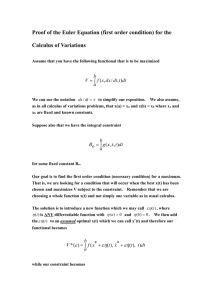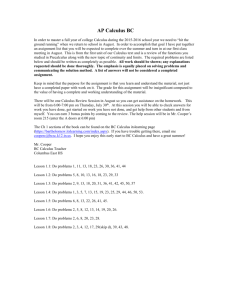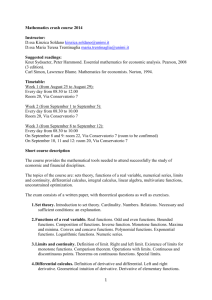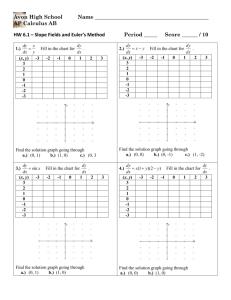Appendix 1
advertisement
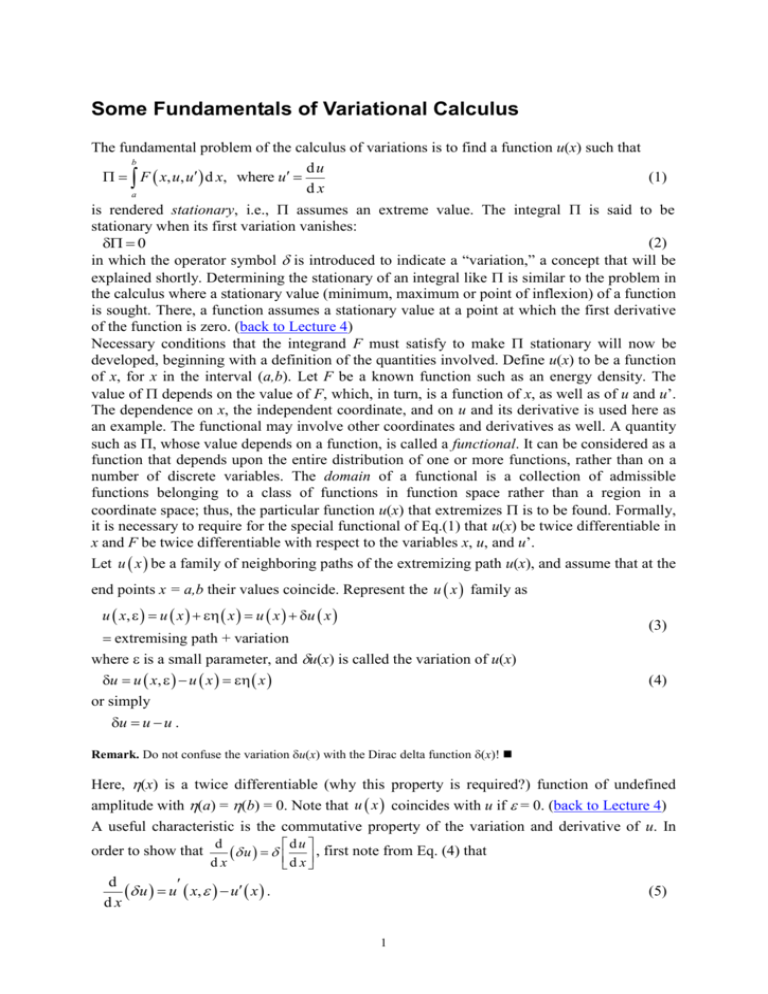
Some Fundamentals of Variational Calculus The fundamental problem of the calculus of variations is to find a function u(x) such that b du (1) F x, u, u d x, where u dx a is rendered stationary, i.e., assumes an extreme value. The integral is said to be stationary when its first variation vanishes: (2) 0 in which the operator symbol is introduced to indicate a “variation,” a concept that will be explained shortly. Determining the stationary of an integral like is similar to the problem in the calculus where a stationary value (minimum, maximum or point of inflexion) of a function is sought. There, a function assumes a stationary value at a point at which the first derivative of the function is zero. (back to Lecture 4) Necessary conditions that the integrand F must satisfy to make stationary will now be developed, beginning with a definition of the quantities involved. Define u(x) to be a function of x, for x in the interval (a,b). Let F be a known function such as an energy density. The value of depends on the value of F, which, in turn, is a function of x, as well as of u and u’. The dependence on x, the independent coordinate, and on u and its derivative is used here as an example. The functional may involve other coordinates and derivatives as well. A quantity such as , whose value depends on a function, is called a functional. It can be considered as a function that depends upon the entire distribution of one or more functions, rather than on a number of discrete variables. The domain of a functional is a collection of admissible functions belonging to a class of functions in function space rather than a region in a coordinate space; thus, the particular function u(x) that extremizes is to be found. Formally, it is necessary to require for the special functional of Eq.(1) that u(x) be twice differentiable in x and F be twice differentiable with respect to the variables x, u, and u’. Let u x be a family of neighboring paths of the extremizing path u(x), and assume that at the end points x = a,b their values coincide. Represent the u x family as u x, u x x u x u x extremising path + variation where is a small parameter, and u(x) is called the variation of u(x) u u x, u x x (3) (4) or simply u u u . Remark. Do not confuse the variation u(x) with the Dirac delta function (x)! Here, (x) is a twice differentiable (why this property is required?) function of undefined amplitude with (a) = (b) = 0. Note that u x coincides with u if = 0. (back to Lecture 4) A useful characteristic is the commutative property of the variation and derivative of u. In order to show that d du u , first note from Eq. (4) that dx d x d u u x, u x . dx (5) 1 Since the variation of u’ is defined as u u x, u x , it can be concluded that d du (6) u . dx dx It should be observed that this holds only for continuous functions possessing derivatives of the requisite order. Although the (delta) operator and the differential calculus d operator are used formally in a similar fashion, they should be clearly distinguished from each other. For the function u(x), the differential calculus quantity du designates the vertical distance between points on a given curve at locations of infinitesimal distance dx apart (Fig. 1). However, u is not associated with neighbouring points on a given curve, but rather represents a small but arbitrary change in the ordinate u for a particular value of x. In Fig. 1, at the specified location x=c, u is the vertical difference between any of the u curves (B or C) and the u curve (A). Note that no x is associated with u. Fig. 1: The delta operator For u specified on the boundary, the variation u must be zero because the specified value of u does not vary at this particular value of x. As a consequence, the variation u is zero where u is specified, and it is arbitrary elsewhere. The variation u is said to undergo a virtual change. As mentioned previously, the operator can be used formally just as one uses the operator d. For example, 2 u 2u u, u v u v, u 0 if u is specified (constant) (7)1 Also, u d x u d x . (7)2 To solve the variational problem of extremizing , we seek the extreme value of the integral by considering 2 b u F x, u , u d x (8) a in the limit as 0. By using u as “admissible function” in the sense that (a) = (b) = 0, we can reduce the problem of extremizing to the ordinary calculus problem of finding the extreme value of , a function of the parameter . That is, since u u for 0, the necessary condition for to be an extreme will be d (9) 0. d 0 Recall that u u . The derivative of with respect to can be expressed as b d b F d u F d u F F d x d x d d u d u a u a u or d b F F d x 0 . (10) d u u a Integration by part of the second term in the integral of Eq. (10) and use of the end conditions (a) = (b) = 0 leads to b F d F (11) a x u d x u d x 0 A basic lemma states that if (x) is a continuous function in a x b, then the relation b x x d x 0 (12) a holds for arbitrary continuous functions (x) with continuous first derivatives if, and only if, (x) 0. This is valid for functions (x) which vanish at the ends. This result is often referred to as the fundamental lemma of the calculus of variations. Since (x) is assumed to satisfy the conditions mentioned above, it follows immediately from Eq. (11) that F d F 0. (13) u d x u This differential equation is called the Euler’s equation associated with . It is a necessary condition for a function u(x) to extremize the functional . (back to Lecture 1) (back to Lecture 2) (back to Lecture 4) (back to Lecture 5-6) (back to Lecture 8) (back to Lecture 910) Example 1. Extension of a Bar The total potential energy in a simple extension bar (length L, Young’s modulus E, cross-sectional area A, axial displacement u, and axial loading px is L 2 1 (1a) EA u px u d x . 2 0 According to the principle of stationary potential energy, a fundamental energy theorem, the kinematically admissible deformations which also satisfy equilibrium must correspond to the assumption of a stationary value of the total potential energy. Thus, for such a bar, vanishes when is given by (1a). By comparison of (1a) with Eq. (1) 1 2 (1b) F x, u , u EA u pxu 2 To derive Euler’s equation, we calculate 3 F F (1c) px , EAu u u Thus, from Eq. (3), F d F d d (1d) px EAu 0, or EAu px u d x u dx dx which is the governing equation for the extension of a simple bar. Equations (1a) and (1d) can be viewed as being different but equivalent analytical representations of the same problem. The differential equation is sometimes referred to as the classical or local model and its solution u must be twice differentiable. The integral equation (1a) is called the variational or global equation for the problem, and the solution of = 0 is sometimes referred to as being weak, since this u need only be differentiable once. Moreover, although not evident here, some boundary conditions usually associated with (1d) are included in the variational integral (1a). It remains to define the conditions under which is rendered stationary when the first variation of vanishes. In other words, it remains to be shown that this stationary value is equivalent to the extreme value represented by Eq. (13). Note that F x, u , u cal also be written using the operator as F x, u u, u u . For a fixed x, expand F in a Taylor series about u and u’ to obtain F F F x, u u , u u F x , u , u u u ... (14) u u plus higher order terms containing (u)2, (u’)2(u)3 etc. Rewrite Eq. (14) as F F F x, u u , u u F x, u , u u u higher order terms . u u The left-hand side of this expression is the change in F due to the variation u for a fixed x, i.e., it is equal to F. The term in square brackets on the right-hand side of Eq. (14) is referred to as the first variation of F, the higher order terms comprise higher order variations. This first variation of a functional expression, F F F u u (15) u u will be used frequently. If the higher order terms are neglected, we can write the first variation of the functional as b b F F F d x u u d x . (16) u u a a Integration by parts of the second term of the integrand permits u to be factored out, and use of the conditions u = 0 at x = a, b leads to b F d F u (17) d x . u d x u a For = 0 with a properly behaving u , the Euler’s equation (13) follows from the fundamental lemma of the calculus of variations. Also, it can be reasoned that since the variations u are arbitrary, setting the integral of Eq. (17) to zero and using the fundamental lemma of the calculus of variations leads to Eulers’s equation. Thus, finding the stationary value of be setting the first variation of equal to zero is equivalent to finding the extremal value of be setting d/d=0 equal zero. It can be shown that as with second derivatives in ordinary calculus, the second variations 2 can be used to characterize the extremum as either a minimum or a maximum, i.e. 2 > 0 minimum of , 2 < 0 maximum of . Some similarities between the differential calculus and the variational calculus are summarized in Table 1. 4 Table 1 Comparison of the ordinary and variational calculus Differential Calculus Problem formulation Involves a function Necessary condition for an First derivative = 0 extreme value Result A single value The type of extreme follows The second derivative from Variational Calculus Involves a function of a function = functional First variation =0 A function The second variation Finally, some remarks concerning the boundary conditions should be made. The integration by parts of the second term in the integrand of Eq. (10) gives F F d F a u d x u a a d x u d x b b b (18) To proceed to Eq. (11), it is necessary to use he condition (a) = (b) = 0. These are referred to as essential boundary conditions. If had been left arbitrary at the boundaries, it would have been necessary to use the condition F/u’ = 0 at x = a, b. These conditions are called the natural boundary conditions. (back to Lecture 1) Example 2. Bending of a Beam The total potential energy of an ordinary beam is L L 1 1 M pz w d x EIw w pz w d x , 2 2 0 0 (2a) (bending moment M, beam curvature w’’, beam deflection w, moment of inertia of the cross-section about the y-axis I, transverse loading pz). To apply the principle of stationary potential energy, we set =0. By comparison of (2a) with Eq. (1), function F is chosen such that 1 (2b) F x, w, w EIw w pz w . 2 Euler’s equation as expressed by Eq. (13) does not apply directly because here F = F(x,w,w’’) contains second but not first derivatives of w. It can be shown, that for such functional, Euler’s equation takes the form F d 2 F (2c) 0. w d x 2 w However, rather than using Euler’s equation directly, the desired governing equation will be derived in the same fashion as Euler’s equation was: L d F F d x 0 d 0 0 w w L L L 0 0 0 L EIw pz d x EIw 0 EIw d x pz d x L (2d) L L EIw 0 EIw EIw pz d x 0 0 L M T 0 EIw pz d x 0 L 0 where the relations for the bending moment M = -EIw‘‘ and the shear force T = -EIw‘‘’ were used. If ,’ = 0 for x = 0, L (the essential boundary conditions) or M,T = 0 x = 0, L (the natural boundary conditions), then (2e) EIw p z 5 is Euler’s equation, which is recognized to be the governing differential equation for beam theory. (back to Lecture 5-6) Usually, governing equations such as (2e) are derived using variational notation as employed in Eqs. (16) and (17). For the case of our beam with given by (2a) L L L F F F d x w w d x EIw w pz w d x w w 0 0 0 L (2f) L L EIw w 0 EIw w d x pz w d x 0 0 L L L EIw w 0 EIw w EIw pz w d x 0 0 0 Thus, EIw pz for all x and w 0 or EIw M 0 at x 0, L w 0 or EIw T 0 (back to Lecture 1) (back to Lecture 3) (2g) Many variational problems involve subsidiary conditions. For example, find the minimum of b F x, u , u d x (19a) a subject to the restriction b J G x, u , u d x 0 (19b) a where G is a known function. This is referred to as an isoperimetric problem. One technique for treating this problem forms the basis of the computational optimization techniques called penalty function methods. Begin by multiplying J by a factor (Lagrange multiplier) and adding the product to the original functional to give a new functional H b H J F x, u , u d x (20) a where F* = + G. Recall that the goal was to extremize subject to J = 0. It is apparent from Eq. (20) that extremizing is the same as extremizing H as long as J = 0. Thus, in a sence, the non-zero J in (20) tends to “penalize” the process of selecting an extreme value of H. The u(x) that extremizes and satisfies J = 0 must also satisfy H = 0. The necessary condition for u to correspond to the extreme value of H is the Euler equation F * d F * 0. (21) u d x u (back to Lecture 4) (back to Lecture 5-6) (back to Lecture 11) Problems 1. What is the curve that joints two points in a plane such that the distance along the arc is a minimum? Hint: Use F 1 u . Solution using Maple (You will need the version Maple8 and higher 2 installed) Answer: u C1 x C2 , a straight line 6 2. (back to Lecture 1) (back to Lecture 4) Consider the transverse deformation of a string of length L in tension N. The transverse load pz causes a transverse deformation w from the original line. Show that for small deformations a line of string of length dx 2 2 1 before loading becomes 1 w d x 1 w d x after loading. Show that the 2 2 strain energy change per unit original length of string is 1 2 N w and that the total 2 1 potential energy of the string is N w pz w d x . Derive Euler’s equation 2 0 in the form Nw pz . Solution using Maple (back to Lecture 7) L 7

